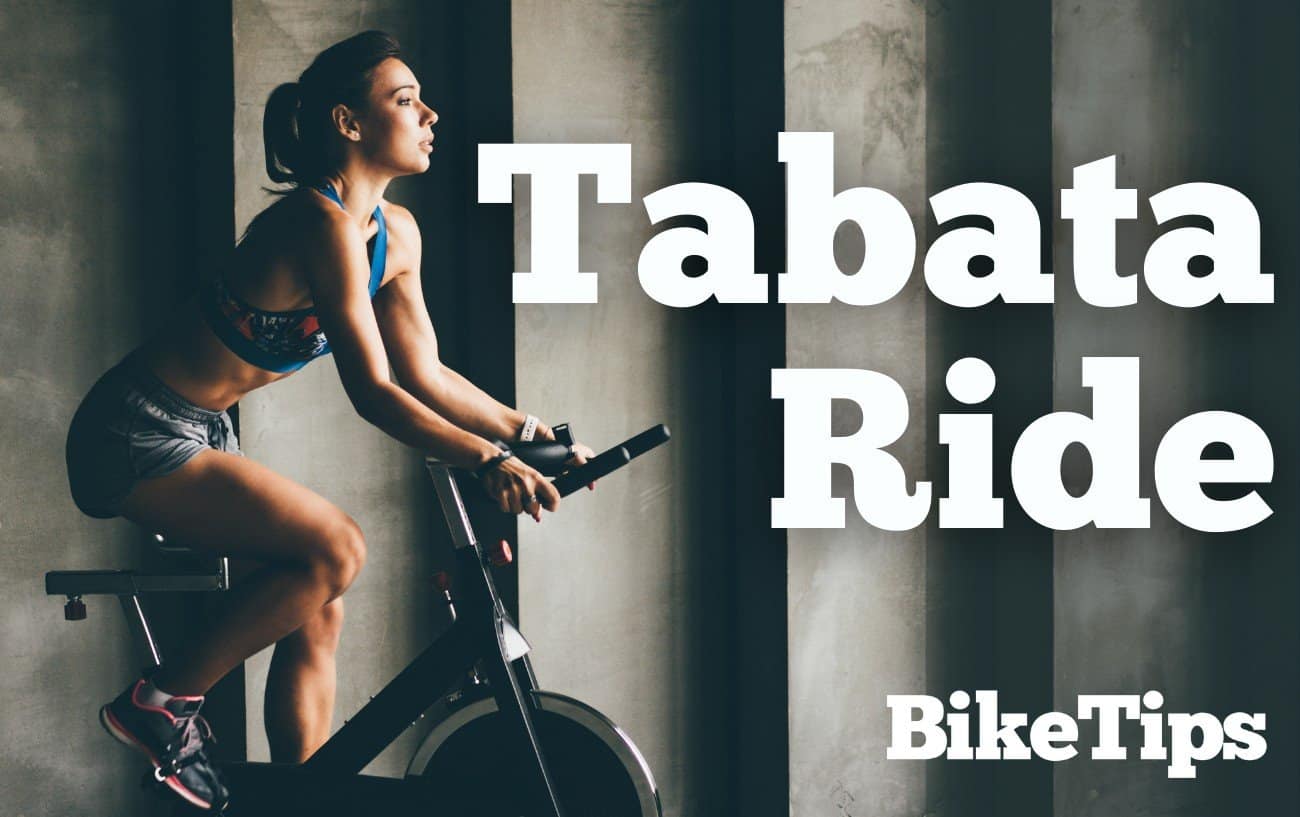Tabata is a specific style of HIIT training that involves extremely high-intensity efforts and very short rest periods in a specific 2:1 ratio of work to rest.
A Tabata ride is a cycling workout that uses the Tabata style for hard-easy intervals.
However, if you’d like to learn more about Tabata workouts to help you reap the most out of these interval rides, or if you have yet to test your legs, lungs, heart, and willpower with a Tabata ride and want to know what you’re in store for to nail your debut, keep reading for our complete guide!
In this article, we’ll be covering:
- What Is a Tabata Ride?
- How Hard Should a Tabata Ride Be?
- Benefits of a Tabata Ride for Cyclists
- Is a Tabata Ride Enough of a Workout?
- How to Perform a Tabata Ride
Ready to get to grips with Tabata ride workouts?
Let’s get started!

What Is a Tabata Ride?
Before we delve into what a Tabata ride entails, let’s provide a refresher on HIIT workouts.
High-intensity interval training (HIIT) is a style of workout that involves alternating between short bursts of vigorous exercise and less intense recovery periods.
By engaging in these hard-easy intervals, HIIT workouts allow you to work at a higher intensity during the “on” periods and keep your heart rate elevated throughout the workout—even while you recover during the “off” intervals.
Most HIIT workouts usually last anywhere from 15-45 minutes, and the work intervals and recovery periods can be any length of time or of any ratio.
For example, a HIIT cycling workout could be 10 x 45 seconds on with 45 seconds easy, 15 x 60 seconds on with 30 seconds easy, or 20 x 15 seconds on 30 seconds easy. The combinations and permutations are endless.
Developed by Dr. Izumi Tabata in 1996, the traditional Tabata format is eight rounds of 20 seconds of nearly maximal-intensity work followed by just 10 seconds of rest, making the entire Tabata workout just 4 minutes long.
Dr. Tabata initially developed the Tabata protocol for cycling, but people now use the Tabata format for any form of exercise from the indoor cycling Tabata ride to sprinting, burpees, push-ups, jumping rope, and so on.
A Tabata ride is a cycling workout that uses the Tabata style for hard-easy intervals. Peloton has branded the Tabata Ride in their workout library, but you can also do a Tabata ride out on your road or mountain bike (or otherwise), trainer, or other indoor cycles.

How Hard Should a Tabata Ride Be?
Because a standard Tabata workout is just four minutes long, the intensity should be even higher than your hard efforts during a HIIT workout.
In fact, the Tabata protocol was intended to be at an intensity that fully exhausts you by the penultimate or last interval (#7 or #8) of the original 8 x 20 seconds on, 10 seconds rest format.
However, the Peloton Tabata Ride classes are longer than 4 minutes. Therefore, they’re more like HIIT workouts in the style of Tabata than genuine Tabata rides.
They usually last 20-30 minutes, but some go up to 45 minutes with the warmup and cool down, so you’ll do more than just eight rounds. As such, the intensity inevitably drops.
You can do your own authentic Tabata ride, though, keeping things at near-maximal intensity with the goal of reaching failure or complete fatigue by the end of the seventh or eighth hard 20-second interval.

Benefits of a Tabata Ride for Cyclists
Just because Tabata rides can be as short as 4 minutes doesn’t mean they’re an easy Sunday spin or ride down the bike path—even if you have the stamina to run a century or more.
You’ll be pushing your body to near-maximal intensity, but the payoff is worth it as there are quite a few benefits you’ll reap from engaging in a Tabata ride, including the following:
- Training your anaerobic energy system as well as the aerobic energy system
- Boosting your metabolism
- Adding variety and fun to a workout routine
- Challenging different energy systems than distance riding
- Providing a time-efficient workout option
- Increasing your cycling power
- Increasing your cycling cadence
- Increasing your cycling sprint speed
- Improving your cycling economy

Is a Tabata Ride Enough of a Workout?
We tend to adopt the mindset that more is better, but when it comes to exercise, this is often far from true.
Even though you’ll find most Tabata rides to be at least two full rounds of the Tabata protocol (2 x 8 x 20 seconds on, 10 seconds off), which would make them 8 minutes long, there is evidence to suggest that even the original 4-minute Tabata ride protocol can be very beneficial.
Studies have demonstrated that 6- to 12-week Tabata training increases the VO2 max by up to 15.0%, and the maximal accumulated oxygen debt (a measure of anaerobic capacity) by up to 35.0%.
Researchers also found that the magnitude of these improvements was similar, if not superior, to those achieved by other HIIT-style workouts – even though the duration of Tabata is significantly shorter.
That said, depending on your cycling performance and fitness goals, a Tabata ride may be more or less appropriate for your training program or may need to be modified to better meet your needs.

Precautions with Tabata Rides
Just as you shouldn’t do a time trial or hard FTP ride every day, so too should you space out Tabata rides.
Due to the intense nature of a Tabata ride, it’s important to give your body at least a few days after one Tabata ride before hitting it again. You can do other recovery rides inbetween.
It is also crucial to remember that while speed and intensity are key in terms of reaping the benefits of Tabata workouts, intensity should never come at the expense of good form.

How to Perform a Tabata Ride
When you’re feeling ready to test your limits and push your body to the max, hop on your bike and take your legs on a pedal-pumping Tabata ride.
You can try a guided Tabata ride by streaming one of the workouts on the Peloton app. There are fun options with top instructors like Robin Arzon, Ally Love, and Olivia Amato, with workout durations of 20-45 minutes.
You’ll do a 5-12 minute warmup and then get going on your 2:1 work-to-rest intervals, hitting it hard for 20 seconds and then resting for 10. The Peloton Tabata rides usually will take you through more than eight total rounds, but some cap it at eight.
You can also perform your own Tabata ride. Whether on cycling outdoors or riding inside on a trainer or stationary bike, here’s how to do a Tabata ride:
Warm-up by cycling at an easy resistance for 5-10 minutes, gradually increasing the resistance and cadence towards the end of the warm-up.
Then, try one of the following Tabata ride variations:
Basic Tabata Ride
- Dial up the resistance and sprint as hard and fast as possible for 20 seconds, followed by 10 seconds of rest. You should be at maximum effort.
- If you’re on an indoor cycle, you can fully stop during the rest or spin lightly. When cycling outdoors, keep your legs moving over the rest but move to the easiest gear and barely pedal.
- Repeat 8 times.
Indoor Hill Tabata Ride
- Complete the same Tabata protocol but come out of the saddle for each work interval and climb.
- Sit for the recovery periods.
After either Tabata ride iteration, do a gentle 5-15 minute cool down with low resistance.

Take On Tabata For Yourself!
Now you know all about what a Tabata ride is and how to perform one, it’s time to put them to use in your own cycling workout plan!
Though you shouldn’t rely solely on Tabata rides, they’re a great way to add variety to your workouts – and as we’ve discovered, they bring massive benefits to your fitness and performance too!
Found this Training Guide useful? Learn more from the BikeTips experts in the articles below!
- How To Make A Bike Stationary: DIY Exercise Bike



